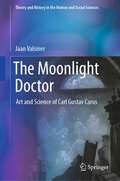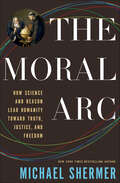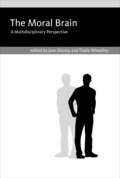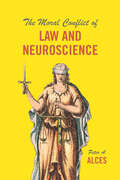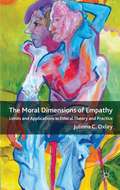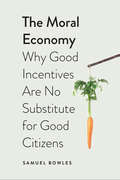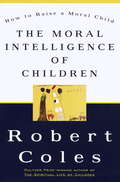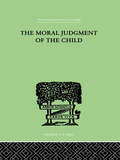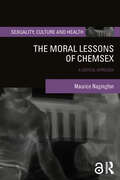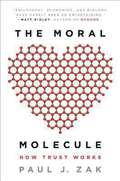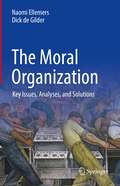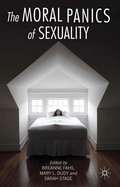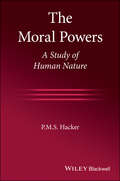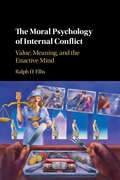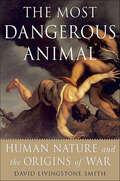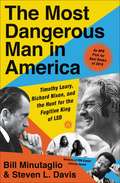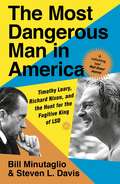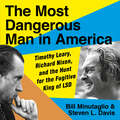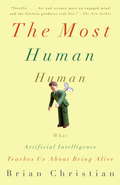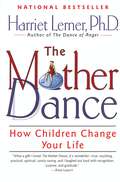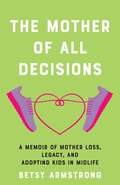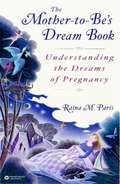- Table View
- List View
The Moonlight Doctor: Art and Science of Carl Gustav Carus (Theory and History in the Human and Social Sciences)
by Jaan ValsinerThis is the very first authoritative book on the role of Carl Gustav Carus (1789-1869) in the history of psychology. Carus was the initiator of the notions of development, unconscious, and archetype in psychology. The book emphasizes the interdisciplinary focus of Carus’ work as it was based on the literature and art of his time and is closely related with medicine and Naturphilosophie. The readership of the book will get access to the life course of a key figure of science of the 19th century.
The Moral Arc: How Science and Reason Lead Humanity Toward Truth, Justice, and Freedom
by Michael ShermerThe New York Times–bestselling author of The Believing Brains explores how science makes us better people.From Galileo and Newton to Thomas Hobbes and Martin Luther King, Jr., thinkers throughout history have consciously employed scientific techniques to better understand the non-physical world. The Age of Reason and the Enlightenment led theorists to apply scientific reasoning to the non-scientific disciplines of politics, economics, and moral philosophy. Instead of relying on the woodcuts of dissected bodies in old medical texts, physicians opened bodies themselves to see what was there; instead of divining truth through the authority of an ancient holy book or philosophical treatise, people began to explore the book of nature for themselves through travel and exploration; instead of the supernatural belief in the divine right of kings, people employed a natural belief in the right of democracy.In The Moral Arc, Shermer explains how abstract reasoning, rationality, empiricism, skepticism—scientific ways of thinking—have profoundly changed the way we perceive morality and, indeed, move us ever closer to a more just world.“Michael Shermer is a beacon of reason in an ocean of irrationality.” —Neil deGrasse Tyson“A memorable book, a book to recommend and discuss late into the night.” —Richard Dawkins“[A] brilliant contribution . . . Sherman’s is an exciting vision.” —Nature
The Moral Brain: A Multidisciplinary Perspective (The\mit Press Ser.)
by Jean Decety Thalia WheatleyAn overview of the latest interdisciplinary research on human morality, capturing moral sensibility as a sophisticated integration of cognitive, emotional, and motivational mechanisms.Over the past decade, an explosion of empirical research in a variety of fields has allowed us to understand human moral sensibility as a sophisticated integration of cognitive, emotional, and motivational mechanisms shaped through evolution, development, and culture. Evolutionary biologists have shown that moral cognition evolved to aid cooperation; developmental psychologists have demonstrated that the elements that underpin morality are in place much earlier than we thought; and social neuroscientists have begun to map brain circuits implicated in moral decision making. This volume offers an overview of current research on the moral brain, examining the topic from disciplinary perspectives that range from anthropology and neurophilosophy to justice and law. The contributors address the evolution of morality, considering precursors of human morality in other species as well as uniquely human adaptations. They examine motivations for morality, exploring the roles of passion, extreme sacrifice, and cooperation. They go on to consider the development of morality, from infancy to adolescence; findings on neurobiological mechanisms of moral cognition; psychopathic immorality; and the implications for justice and law of a more biological understanding of morality. These new findings may challenge our intuitions about society and justice, but they may also lead to more a humane and flexible legal system.ContributorsScott Atran, Abigail A. Baird, Nicolas Baumard, Sarah Brosnan, Jason M. Cowell, Molly J. Crockett, Ricardo de Oliveira-Souza, Andrew W. Delton, Mark R. Dadds, Jean Decety, Jeremy Ginges, Andrea L. Glenn, Joshua D. Greene, J. Kiley Hamlin, David J. Hawes, Jillian Jordan, Max M. Krasnow, Ayelet Lahat, Jorge Moll, Caroline Moul, Thomas Nadelhoffer, Alexander Peysakhovich, Laurent Prétôt, Jesse Prinz, David G. Rand, Rheanna J. Remmel, Emma Roellke, Regina A. Rini, Joshua Rottman, Mark Sheskin, Thalia Wheatley, Liane Young, Roland Zahn
The Moral Conflict of Law and Neuroscience
by Peter A. AlcesLaw relies on a conception of human agency, the idea that humans are capable of making their own choices and are morally responsible for the consequences. But what if that is not the case? Over the past half century, the story of the law has been one of increased acuity concerning the human condition, especially the workings of the brain. The law already considers select cognitive realities in evaluating questions of agency and responsibility, such as age, sanity, and emotional distress. As new neuroscientific research comprehensively calls into question the very idea of free will, how should the law respond to this revised understanding? Peter A. Alces considers where and how the law currently fails to appreciate the neuroscientific revelation that humans may in key ways lack normative free will—and therefore moral responsibility. The most accessible setting in which to consider the potential impact of neuroscience is criminal law, as certain aspects of criminal law already reveal the naiveté of most normative reasoning, such as the inconsistent treatment of people with equally disadvantageous cognitive deficits, whether congenital or acquired. But tort and contract law also assume a flawed conception of human agency and responsibility. Alces reveals the internal contradictions of extant legal doctrine and concludes by considering what would be involved in constructing novel legal regimes based on emerging neuroscientific insights.
The Moral Dimensions of Empathy
by Julinna C. OxleyDoes empathy help us to be moral? The author argues that empathy is often instrumental to meeting the demands of morality as defined by various ethical theories. This multi-faceted work links psychological research on empathy with ethical theory and contemporary trends in moral education.
The Moral Economy: Why Good Incentives Are No Substitute for Good Citizens
by Samuel BowlesShould the idea of economic man--the amoral and self-interested Homo economicus--determine how we expect people to respond to monetary rewards, punishments, and other incentives? Samuel Bowles answers with a resounding "no. " Policies that follow from this paradigm, he shows, may "crowd out" ethical and generous motives and thus backfire. But incentives per se are not really the culprit. Bowles shows that crowding out occurs when the message conveyed by fines and rewards is that self-interest is expected, that the employer thinks the workforce is lazy, or that the citizen cannot otherwise be trusted to contribute to the public good. Using historical and recent case studies as well as behavioral experiments, Bowles shows how well-designed incentives can crowd in the civic motives on which good governance depends.
The Moral Intelligence of Children
by Robert ColesThe Pulitzer Prize-winning author of the bestselling The Spiritual Life of Children now explores how to develop character in children, from infancy through the teenage years. During three stages in the "moral archaeology of childhood, " Coles shows how to spot moral crossroads, and what to do about them.From the Hardcover edition.
The Moral Judgment Of The Child (International Library Of Psychology Ser.)
by Piaget, JeanFirst Published in 1999. Routledge is an imprint of Taylor & Francis, an informa company.
The Moral Lessons of Chemsex: A Critical Approach (Sexuality, Culture and Health)
by Maurice NagingtonThis book explores how gay and bi men’s lived experiences of chemsex intersect with its cultural representations. It argues that while normative moral frameworks are often used to talk about chemsex, chemsex sub-cultures contain their own valuable moral frameworks that can provide lessons about some of the most pressing concerns of contemporary society.Drawing from a tradition of scholarship that views queer sub-cultures as having pedagogical value for all of society, Maurice Nagington critiques norms that govern lives in relation to: the interactions of bodies, sex and capitalism, trauma and tragedy, the regulation of boundaries, and the disciplinary apparatuses in modern society. Each chapter takes its lead from themes informed by the analysis of longitudinal interviews conducted over a two-year period by the author and an archive of materials concerning chemsex such as films, soundtracks, health promotion pamphlets, newspaper articles, blogs, and ethnographic field notes. Linking the accounts of interviewees to wider debates about and representations of chemsex, this innovative book develops a cohesive narrative about the moral lessons chemsex can teach us.Contributing to the emerging field of critical chemsex studies, this volume is of interest to advanced students and scholars interested in gender and sexuality studies, sociology of health and illness, medical anthropology, critical public health and criminology, as well those who are involved in chemsex and wish to read and reflect about it as more than just a problem. The Open Access version of this book, available at http://www.taylorfrancis.com, has been made available under a Creative Commons [Attribution-Non Commercial-No Derivatives (CC-BY-NC-ND)] 4.0 license.
The Moral Molecule: The Source of Love and Prosperity
by Paul J. ZakA Revolution in the Science of Good and EvilWhy do some people give freely while others are cold hearted?Why do some people cheat and steal while others you can trust with your life?Why are some husbands more faithful than others—and why do women tend to be more generous than men?Could they key to moral behavior lie with a single molecule?From the bucolic English countryside to the highlands of Papua New Guinea, from labs in Switzerland to his campus in Souther California, Dr. Paul Zak recounts his extraordinary stories and sets out, for the first time, his revolutionary theory of moral behavior. Accessible and electrifying, The Moral Molecule reveals nothing less than the origins of our most human qualities—empathy, happiness, and the kindness of strangers. .
The Moral Organization: Key Issues, Analyses, and Solutions
by Naomi Ellemers Dick de GilderInvestors, customers and employees increasingly expect organizations to take responsibility for the social impact of their activities. This book applies theory and research on moral psychology and social identity, to offer a new perspective on organizational social responsibility and business ethics. The authors use their unique approach to highlight recurring moral challenges in organizational behavior, such as leadership, work motivation, diversity, organizational change and stakeholder relations. Their analysis explains that people are reluctant to acknowledge and confront moral flaws in their workplace behavior, because this constitutes a source of identity threat. Common strategies to cope with this threat invite justifications and symbolic actions – and prevent moral improvement. Each chapter draws together a wealth of research findings and organizational cases. These not only identify and clarify common moral pitfalls, but also show ways to enhance the likelihood that organizations acquire the knowledge, willingness and ability to build an ethical work climate.
The Moral Panics of Sexuality
by Sarah Stage Breanne Fahs Mary L. DudyA provocative feminist analysis of the moral panics of sexuality, this interdisciplinary edited collection showcases the range of historical and contemporary crises we too often suppress, including vagina dentata, vampires, cannibalism, age appropriateness, breast cancer, menstrual panics, and sex education.
The Moral Powers: A Study of Human Nature
by P. M. HackerA milestone in the study of value in human life and thought, written by one of the world’s preeminent living philosophers The Moral Powers: A Study of Human Nature is a philosophical investigation of the moral potentialities and sensibilities of human beings, of the meaning of human life, and of the place of death in life. It is an essay in philosophical anthropology: the study of the conceptual framework in terms of which we think about, speak about, and investigate homo sapiens as a social and cultural animal. This volume examines the diversity of values in human life and the place of moral value within the varieties of values. Its subject is the nature of good and evil and our propensity to virtue and vice. Acting as the culmination of five decades of reflection on the philosophy of mind, epistemology, ethics, and human nature, this volume: Concludes Hacker’s acclaimed Human Nature tetralogy: Human Nature: The Categorial Framework, The Intellectual Powers: A Study of Human Nature, and The Passions: A Study of Human Nature Discusses traditional ideas about ethical value and addresses misconceptions held by philosophers, psychologists, and cognitive neuroscientists The Moral Powers: A Study of Human Nature is required reading philosophers of mind, ethicists, psychologists, cognitive neuroscientists, and any general reader wanting to understand the nature of value and the place of ethics in human lives.
The Moral Psychology of Internal Conflict
by Ralph D. EllisPushing back against the potential trivialization of moral psychology that would reduce it to emotional preferences, this book takes an enactivist, self-organizational, and hermeneutic approach to internal conflict between a basic exploratory drive motivating the search for actual truth, and opposing incentives to confabulate in the interest of conformity, authoritarianism, and cognitive dissonance, which often can lead to harmful worldviews. The result is a new possibility that ethical beliefs can have truth value and are not merely a result of ephemeral altruistic or cooperative feelings. It will interest moral and political psychologists, philosophers, social scientists, and all who are concerned with inner emotional conflicts driving ethical thinking beyond mere emotivism, and toward moral realism, albeit a fallibilist one requiring continual rethinking and self-reflection. It combines 'basic emotion' theories (e. g. Panksepp) with hermeneutic depth psychology. The result is a realist approach to moral thinking emphasizing coherence rather than foundationalist theory of knowledge.
The Morning Notes of Adelbert Ames, Jr.
by Adelbert AmesThis volume may come as a surprising adventure of the mind even to his peers in the field of perceptual psychology. Here is a book as unusual as the innovating research it describes. The main body consists of "morning notes" - memoranda written by Ames as progressive clarifications of his thinking and investigation into the "seeming" by which human beings live and relate themselves to the fundamentally unknowable world of assumed "reality".
The Most Dangerous Animal: Human Nature and the Origins of War
by David Livingstone Smith“Original and compelling insights into the human capacity for war . . . A must read for anyone interested in the psychological depths of human nature.” —Barbara S. Held, author of Back to RealityAlmost 200 million human beings, mostly civilians, have died in wars over the last century, and there is no end of slaughter in sight.The Most Dangerous Animal asks what it is about human nature that makes it possible for human beings to regularly slaughter their own kind. It tells the story of why all human beings have the potential to be hideously cruel and destructive to one another. Why are we our own worst enemy? The book shows us that war has been with us—in one form or another—since prehistoric times, and looking at the behavior of our close relatives, the chimpanzees, it argues that a penchant for group violence has been bred into us over millions of years of biological evolution. The Most Dangerous Animal takes the reader on a journey through evolution, history, anthropology, and psychology, showing how and why the human mind has a dual nature: on the one hand, we are ferocious, dangerous animals who regularly commit terrible atrocities against our own kind, on the other, we have a deep aversion to killing, a horror of taking human life.Meticulously researched and far-reaching in scope and with examples taken from ancient and modern history, The Most Dangerous Animal delivers a sobering lesson for an increasingly dangerous world.“Illuminates an exceedingly dark subject: humankind’s deep-seated penchant for war. The result is a discerning, insightful, highly original, and very disturbing book.” —Andrew J. Bacevich, author of The Age of Illusions
The Most Dangerous Man in America: Timothy Leary, Richard Nixon and the Hunt for the Fugitive King of LSD
by Bill Minutaglio Steven L. DavisFrom Bill Minutaglio and Steven L. Davis, authors of the PEN Center USA award-winning Dallas 1963, comes a madcap narrative about Timothy Leary's daring prison escape and run from the law.On the moonlit evening of September 12, 1970, an ex-Harvard professor with a genius I.Q. studies a twelve-foot high fence topped with barbed wire. A few months earlier, Dr. Timothy Leary, the High Priest of LSD, had been running a gleeful campaign for California governor against Ronald Reagan. Now, Leary is six months into a ten-year prison sentence for the crime of possessing two marijuana cigarettes.Aided by the radical Weather Underground, Leary's escape from prison is the counterculture's union of "dope and dynamite," aimed at sparking a revolution and overthrowing the government. Inside the Oval Office, President Richard Nixon drinks his way through sleepless nights as he expands the war in Vietnam and plots to unleash the United States government against his ever-expanding list of domestic enemies. Antiwar demonstrators are massing by the tens of thousands; homemade bombs are exploding everywhere; Black Panther leaders are threatening to burn down the White House; and all the while Nixon obsesses over tracking down Timothy Leary, whom he has branded "the most dangerous man in America."Based on freshly uncovered primary sources and new firsthand interviews, THE MOST DANGEROUS MAN IN AMERICA is an American thriller that takes readers along for the gonzo ride of a lifetime. Spanning twenty-eight months, President Nixon's careening, global manhunt for Dr. Timothy Leary winds its way among homegrown radicals, European aristocrats, a Black Panther outpost in Algeria, an international arms dealer, hash-smuggling hippies from the Brotherhood of Eternal Love, and secret agents on four continents, culminating in one of the trippiest journeys through the American counterculture.
The Most Dangerous Man in America: Timothy Leary, Richard Nixon and the Hunt for the Fugitive King of LSD
by Bill Minutaglio Steven L. Davis'It's a rollicking tale that brings to life the antic atmosphere of America in the 'Me' Decade' Wall Street Journal'A madcap chase... this is a well-written chronicle of 28 months when the world went slightly mad' Sunday Times'A suitably head-spinning account of LSD High Priest Dr Timothy Leary' Mail on SundayOn the moonlit evening of September 12, 1970, an ex-Harvard professor with a genius IQ studies a twelve-foot high fence topped with barbed wire. A few months earlier, Dr. Timothy Leary, the High Priest of LSD, had been running a gleeful campaign for California governor against Ronald Reagan. Now, Leary is six months into a ten-year prison sentence for the crime of possessing two marijuana cigarettes.Aided by the radical Weather Underground, Leary's escape from prison is the counterculture's union of "dope and dynamite," aimed at sparking a revolution and overthrowing the government. Inside the Oval Office, President Richard Nixon drinks his way through sleepless nights as he expands the war in Vietnam and plots to unleash the United States government against his ever-expanding list of domestic enemies. Antiwar demonstrators are massing by the tens of thousands; homemade bombs are exploding everywhere; Black Panther leaders are threatening to burn down the White House; and all the while Nixon obsesses over tracking down Timothy Leary, whom he has branded "the most dangerous man in America."Based on freshly uncovered primary sources and new firsthand interviews, THE MOST DANGEROUS MAN IN AMERICA is an American thriller that takes readers along for the gonzo ride of a lifetime. Spanning twenty-eight months, President Nixon's careening, global manhunt for Dr. Timothy Leary winds its way among homegrown radicals, European aristocrats, a Black Panther outpost in Algeria, an international arms dealer, hash-smuggling hippies from the Brotherhood of Eternal Love, and secret agents on four continents, culminating in one of the trippiest journeys through the American counterculture.
The Most Dangerous Man in America: Timothy Leary, Richard Nixon and the Hunt for the Fugitive King of LSD
by Bill Minutaglio Steven L. Davis'It's a rollicking tale that brings to life the antic atmosphere of America in the 'Me' Decade' Wall Street Journal'A madcap chase... this is a well-written chronicle of 28 months when the world went slightly mad' Sunday TimesFrom Bill Minutaglio and Steven L. Davis, authors of the PEN Center USA award-winning Dallas 1963, comes a madcap narrative about Timothy Leary's daring prison escape and run from the law.On the moonlit evening of September 12, 1970, an ex-Harvard professor with a genius IQ studies a twelve-foot high fence topped with barbed wire. A few months earlier, Dr. Timothy Leary, the High Priest of LSD, had been running a gleeful campaign for California governor against Ronald Reagan. Now, Leary is six months into a ten-year prison sentence for the crime of possessing two marijuana cigarettes.Aided by the radical Weather Underground, Leary's escape from prison is the counterculture's union of "dope and dynamite," aimed at sparking a revolution and overthrowing the government. Inside the Oval Office, President Richard Nixon drinks his way through sleepless nights as he expands the war in Vietnam and plots to unleash the United States government against his ever-expanding list of domestic enemies. Antiwar demonstrators are massing by the tens of thousands; homemade bombs are exploding everywhere; Black Panther leaders are threatening to burn down the White House; and all the while Nixon obsesses over tracking down Timothy Leary, whom he has branded "the most dangerous man in America."Based on freshly uncovered primary sources and new firsthand interviews, THE MOST DANGEROUS MAN IN AMERICA is an American thriller that takes readers along for the gonzo ride of a lifetime. Spanning twenty-eight months, President Nixon's careening, global manhunt for Dr. Timothy Leary winds its way among homegrown radicals, European aristocrats, a Black Panther outpost in Algeria, an international arms dealer, hash-smuggling hippies from the Brotherhood of Eternal Love, and secret agents on four continents, culminating in one of the trippiest journeys through the American counterculture.(P)2018 Hachette Audio
The Most Human Human: What Talking with Computers Teaches Us About What It Means to Be Alive
by Brian ChristianThe Most Human Human is a provocative, exuberant, and profound exploration of the ways in which computers are reshaping our ideas of what it means to be human. Its starting point is the annual Turing Test, which pits artificial intelligence programs against people to determine if computers can "think." Named for computer pioneer Alan Turing, the Turing Test convenes a panel of judges who pose questions--ranging anywhere from celebrity gossip to moral conundrums--to hidden contestants in an attempt to discern which is human and which is a computer. The machine that most often fools the panel wins the Most Human Computer Award. But there is also a prize, bizarre and intriguing, for the Most Human Human. In 2008, the top AI program came short of passing the Turing Test by just one astonishing vote. In 2009, Brian Christian was chosen to participate, and he set out to make sure Homo sapiens would prevail. The author's quest to be deemed more human than a computer opens a window onto our own nature. Interweaving modern phenomena like customer service "chatbots" and men using programmed dialogue to pick up women in bars with insights from fields as diverse as chess, psychiatry, and the law, Brian Christian examines the philosophical, biological, and moral issues raised by the Turing Test. One central definition of human has been "a being that could reason." If computers can reason, what does that mean for the special place we reserve for humanity?From the Hardcover edition.
The Most Important Thing: learn true love and feel good
by Gabriella GuminaThe Most Important Thing by Gabriella Gumina learn true love and feel good The text is a short and very concrete manual to learn how to improve the quality of one's relationships and be comfortable with oneself and with others.
The Mother Dance
by Harriet LernerFrom the celebrated author of The Dance of Anger comes an extraordinary book about mothering and how it transforms us -- and all our relationships -- inside and out. Written from her dual perspective as a psychologist and a mother, Lerner brings us deeply personal tales that run the gamut from the hilarious to the heart-wrenching. From birth or adoption to the empty nest, The Mother Dance teaches the basic lessons of motherhood: that we are not in control of what happens to our children, that most of what we worry about doesn't happen, and that our children will love us with all our imperfections if we can do the same for them. Here is a gloriously witty and moving book about what it means to dance the mother dance.
The Mother in Psychoanalysis and Beyond: Matricide and Maternal Subjectivity
by Christina Moutsou Rosalind MayoThe question of what it means to be a mother is a very contentious topic in psychoanalysis and in wider society. The Mother in Psychoanalysis and Beyond explores our relationship to the maternal through psychoanalysis, philosophy, art and political and gender studies.Over two years, a group of psychotherapists and members of the public met at the Philadelphia Association for a series of seminars on the Maternal. In the discussions that followed, a chasm opened up slowly and painfully between the idealised longings and fantasies we all share and the realities of maternal experiences: here were met the great silences of love, loss, longing, memories, desire, hatred and ambivalence. This book is the result of this bringing together in conversation and reflections of what so often seems unsayable about the Mother. It examines how issues of personal and gender identity are shaped by the ideals of separation from the mother, the fears and anxiety of merging with the mother, and how this has often led, in psychoanalysis and society, to holding mothers responsible for a variety of personal and social ills and problems in which maternal vulnerability is denied and silenced. There are two main themes running throughout the book: Matricide and Maternal Subjectivity. On the theme of matricide, several contributors discuss the ways in which the discourse and narratives of the Mother have been silenced on a sociocultural level and within psychoanalysis and philosophy in favour of discourses that promote independence, autonomy, power and the avoidance and denial of our fundamental helplessness and vulnerability. On the theme of maternal subjectivity, several chapters look at the actual experience of mothering and/or our relationship to our mother, to highlight the ways in which the maternal is intimately connected with human subjectivity. The Mother in Psychoanalysis and Beyond provides new and provocative thinking about the maternal and its place in various contemporary discourses. It will appeal to psychoanalysts, psychotherapists and psychologists of different schools, scholars and advanced students of art, gender studies, politics and philosophy as well as anyone interested in maternity studies and the relationship between the maternal and human subjectivity.
The Mother of All Decisions: A Memoir of Mother Loss, Legacy, and Adopting Kids in Midlife
by Betsy ArmstrongIn the blink of an eye life can become a reminder of the dreams and goals you let go of. When Betsy Armstrong&’s mother unexpectedly dies, she makes the choice to be better than the mistakes of her family&’s past and build anew in the life she wants and dreams of.What is legacy, and how will I leave one? Betsy Armstrong asks herself this question after her forty-six-year-old mother dies with a list of regrets and her stepfather completely disinherits her. Alone, Betsy sets about building a life of no regrets: becoming a marathon runner and Ironman triathlete, quitting a cushy corporate job to lead a life of service, and overcoming a crippling fear of commitment to marry. Still, she&’s always running from the grief she can&’t escape. As Betsy&’s forty-seventh birthday approaches, she finally confronts her losses and begins reflecting on the one thing she&’d never considered: children. Inspired by a friend&’s adoption, Betsy and her husband, Doug, choose that path but face daunting obstacles—a failed adoption, a Russian courtroom drama, and a medical crisis in a tiny Russian town seven time zones away from Moscow. As the outcome of the adoption waxes and wanes, Betsy is forced to make the biggest decision of her life: How far will she go to become a mother?
The Mother-to-Be's Dream Book: Understanding the Dreams of Pregnancy
by Raïna M. ParisDiscover how dreams can enhance the wonderful bond between you and your baby...
